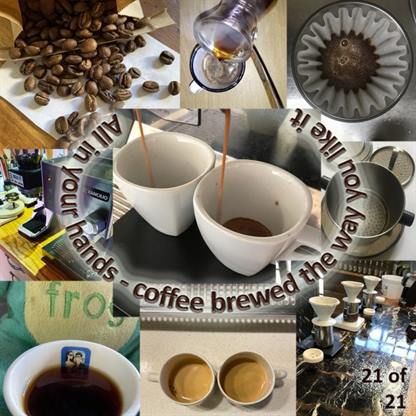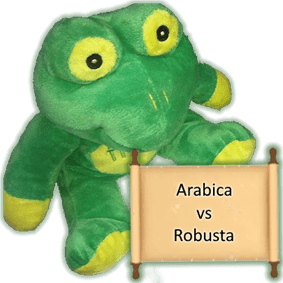Step 1: From Seed to Seedling
Did you know that it takes 2 days to determine if a seed has a viable embryo? The seed is soaked for two days and then those that germinate are planted as seedlings. Around 60 days later the seedling is open. Taking its first “steps”. (Pictures from our visit to @beavercreekcoffee estate)
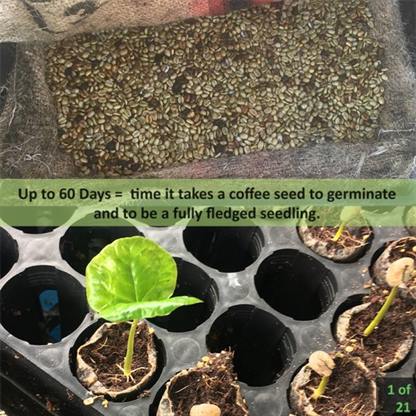
Step 2: From Seedling to Coffee Bush
It takes up to 220 days for a coffee seedling to become a little coffee bush. Now it is ready to settle in. It can be replanted around 90 days but is best to let it grow strong. It is still only a toddler finding its way.
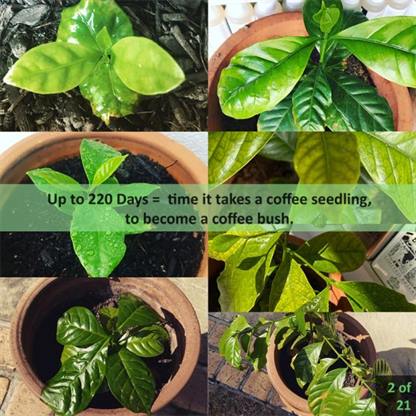
Step 3: The Coffee Blossom
A coffee blossom lasts 3-4 days. It takes a coffee tree (that has the correct soil and climate) 730-1100 days to produce its first blossoms. Trees can have both blossom and fruit at the same time. It is said that sailors could smell the coffee blossoms miles out to sea when they sailed to the Indonesian coffee plantations. This is the beginning of the magic. The work the farmer has done up to now and in the next months (with the help of Mother Nature) will determine yield quality and quality.
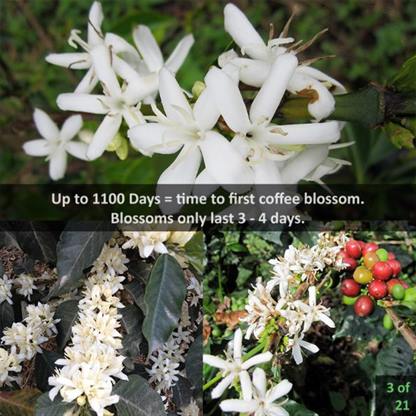
Step 4: From Blossom to Ripe Fruit
From the first blossom until the final ripe fruit, it takes up to 210 days for a coffee tree to finish fruiting. The actual time depends on the nutrition the plant has, the climate and the farmers management of pests, fungus and disease.
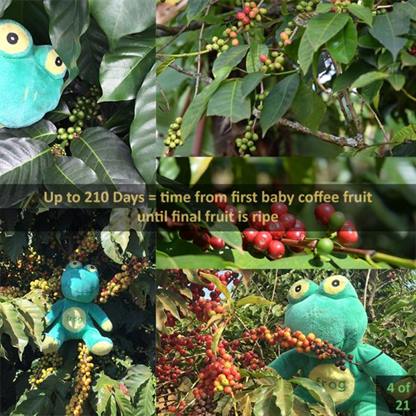
Step 5: Coffee Ripening and Picking
Coffee Ripening and Picking: From the first bud to the ripe coffee fruit takes up to 56 days. Each region that grows coffee, the number of days it takes to pick all the fruit, varies dramatically. Countries like Colombia will have two crops per 365/6 days, while in Ethiopia all the picking typically must be done in 90 days. In some regions, it takes up to 274 days from the first to the final ripe coffee fruit.
Just as all regions have different times for ripening, the way coffee is picked varies. While there are only four basic methods (mechanical, stripped, by hand, and collection from the ground) the way these are implemented also varies.
Stripped is the most destructive, and mainly prevalent for quantity focused farmers.
Mechanical picking requires a flat surface and can either be done by brute force (typically as few pickings as possible) or with a high degree of accuracy. For example, the Brazillian Sao Paolo we offer has up to 10 mechanical pickings. Each picking is performed only at the height that the cherries have reached the desired sugar level.
Picking by hand can also have mixed results. A picker that picks all the coffee cherries that they are able to, can pick on average 90kgs of cherry a day. While those picking only ripe will be lucky to get 60kgs on a good day. Because many pickers are seasonal workers, this can affect the final quality of the cherry. By the way, only 20% of the weight is the actual pip (which will be called the coffee bean at the end).
The final way coffee is collected, is from the ground. Either as a result of fruit falling off the trees or from a process that resulted in the coffee cherry (or pip) to make it to the ground. Be it wind, civet cats, monkeys or an untimely rainstorm.
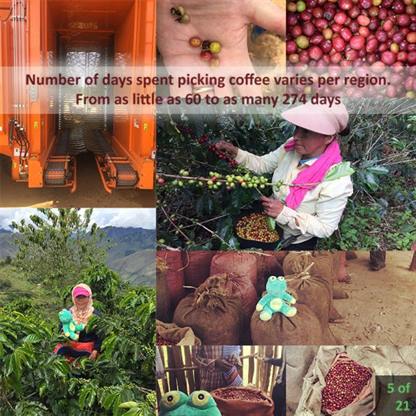
Step 6: Pre-process sorting
For those coffee producers that are quality-focused, picked cherries are floated or manually sorted.
The Manual method happens for small farms that have no way to float their cherries. The cherries are then sorted by colour. As there are many colours a coffee cherry can be when ripe, local knowledge is vital here. No water is required for this process.
For small farms or even cherry buying points, cherries can be put in a bucket, tub or large container. By adding water, the unripe and damaged (by insect, fungus, disease or environment) cherries will then float since their density is lower than water. This method catches a large number of defects early. The more stages that quality is checked, the better the end product will be.
For large farms, especially these that will do natural or pulp-natural processing, Often the method of floating the bean is automated. This is also common post initial processing, but we will cover that tomorrow.
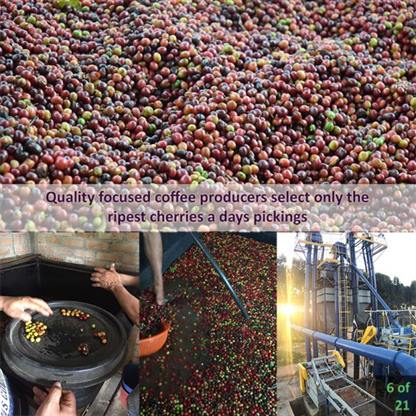
Step 7: Processing of the Coffee Cherry
Many believe post-harvest processing is almost as important, if not more important than the quality of the cherry the tree produces.
At the end of a day’s picking or when the cherry container is filled, processing begins. Most processing fits into one of three methods: Natural/dry-process, Pulp-natural/honey or Wet/Washed.
Natural coffee: in quality-focused production, the naturals would have been floated, and only the dense cherries are then laid out on drying tables or patios. Most naturals, however, are merely picked and spread across patios to dry in the sun. From picking to laying out is typically the same day.
Pulp natural coffees or honey coffees: the depth that the de-pulper goes into the fruit is set as desired by the farmer/processor. This will vary the amount of fruit pulp left on the coffee. A direct link to the final desired cup quality is often the determining factor here. Although sometimes de-pulping is done to speed the drying of the pip up, so that is also a factor. Sometimes the beans are de-pulped without water and sometimes with. If de-pulped with water, then they are typically floated to isolate the damaged and low quality coffee (less dense), as described in the previous step. Once the cherries are de-pulped, they are collected and laid out on patios or drying beds. This is typically the same day as picking.
Washed coffees: These are often considered the highest quality coffee, although well-processed coffee of all types now offer great coffee. Washed coffees are de-pulped with water. For quality-focused producers or farmers, the resulting de-pulped cherry will be floated. The ones that sink are denser and hence are the highest quality the others are lower quality. In Ethiopia, this is called Q1 and Q2. The de-pulped cherry is then typically placed into a vessel of some sort. In Colombia, these are often modified or tiled baths, in most of Africa these are generally large cement throughs. Either way, this de-pulped cherry will stay there until the fruit pulp separates from the pip. The time this takes varies dramatically worldwide. There is much debate about why.
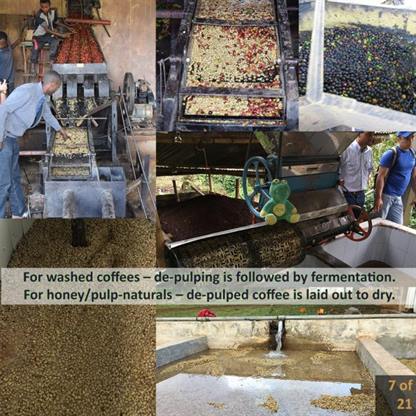
Step 8: Sorting, Tossing and Drying the Coffee
Probably the most labour intense part of the process of getting coffee from a seed to a cup. And hence lots to explain. This process takes the cherry, either after de-pulping (via methods mention yesterday) or in whole form and dries the pip inside. The desired final moisture percentage depends on origin. Typically the pip starts with a moisture content of between 60-70%. For the wet- process or machine-dried process, the target is approximately 40%. For most other coffees it is around 12% (final % varies per country).
Below we will cover this process for those producers that try to achieve a minimum quality standard. However, a lot of coffee is simply laid out on the side of the road, on roofs or on patios. This coffee is then left for days. Patio dried coffees are often raked, over and over. On farms with large patios, tossing may be done with a machine.
For those farmers that work with cooperatives, they are paid a wage by the cooperatives to do this process. Large farms and cooperatives also hire seasonal workers to do this (and pick the coffee too). Smaller farmers will often do all this work themselves, or perhaps get the family to help.
For washed coffee, the process begins after the fermentation period, as mentioned yesterday. For cooperatives and large scale producers in most of Africa, the “fermented coffee” is drained from storage tanks into washing channels. In these channels, coffee is moved through a series of weirs. In each weir, coffee is moved back and forth using closed, wooden rakes. Low density (or low quality) coffee will float at this point and pass over the weirs. This lower quality coffee is usually dried separately. It is either sold as a lower grade or to the local market. After passing through the many weirs, the coffee is then caught in these large sieve type racks and then moved to the raised drying tables or patios.
For small scale farmers, all of this is done in small batches. Using small baths over and over again and then leaving the coffee on raised tables or the parabolic dryers in countries with a lot of rain.
No matter what the process thus far, the processes now converge.
Each day the coffee pips are repeatedly tossed. As part of this tossing, any defective pips are removed. Side note: some call them beans, we tend to think they change their name just before they become famous and go to the mill. At the end of each day, the coffee is usually covered with a tarpaulin. For parabolic dryers, the sides are closed.
Moisture content is tested regularly, and once the desired moisture percentage is achieved the coffee is moved off the tables and into storage. Storage can either be a large shaded room or coffee bags (the type depends on the origin and farmer).
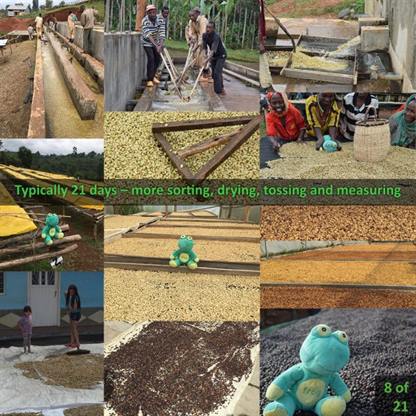
Step 9: Coffee Assessment
Once the coffee pip is dried, it is called parchment coffee. This name comes from a layer over the coffee pip that further protects the pip. Parchment coffee ages very slowly, many believe the green coffee bean (what is roasted) can last years in parchment.
Initial QC and reward: In some countries where farmers and producers do their own processing up until this point, they can get this coffee assessed. While this part of the process is not widely prevalent in Africa and Asia, many Central and South America countries offer this.
Farmers and processors take their parchment coffee to be assessed by local QC centres. For Caravela these are the local offices where PECA people are based.
Once at the centre the coffee from the bags is assessed in small (typically 300g) lots. Usually, a long spear type probe (see pic) is passed through the coffee. This cross-section assessment prevents the case where only good coffee is placed on the top. The coffee moisture level is then checked to see if it is in the desired range (as mentioned above, this varies per country and milling process used). If so, the parchment is removed (using a small mill – like the one Frog Quaffer is sitting on).
The coffee is then sorted by size using a small size sorter (can be by hand or machine – as shown). A minimum number of the maximum size grade is required to proceed. By hand, the coffee is assessed for minor and major flaws. With a minimum count of defects as per the QC, the coffee is then put aside to be roasted.
The coffee is then sample roasted according to the QC specs and set aside to be cupped. Once cupped, a score is prepared. The score determines the final price that the farmer or producer is offered for the coffee.
Any coffee that is rejected is given back to the farmer/producer to sell as commodity-grade coffee.
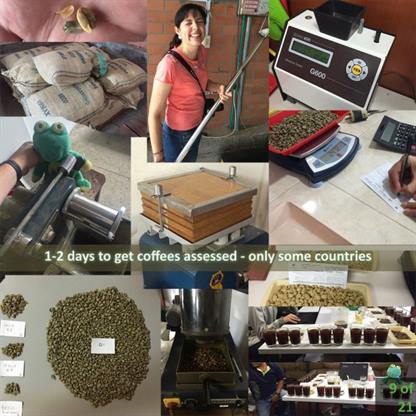
Step 10: Transport
Transport to the warehouse or mill, duration 1-5 days. One of many coffee processes that is often neglected.
Coffee needs to travel from the various processing stations, initial collection agencies (like mentioned yesterday) or on-farm warehouses.
Processes now leave behind the farmer and processor (or washing station). Exceptions are the very rare occasions when the farmer does all the processing up to export. Most producing countries control the milling of the coffee. By only issuing licenses to a small number of warehouses and mills, the rest of the process is controlled.
Many African countries will also control the transport of parchment coffee. Only licensed operators are allowed to transport to warehouses and mills.
Almost all the origins have treacherous roads on which this transport is done. Sometimes only 500kms needs to be travelled; this can take up to 5 days (if nothing major goes wrong). Some of the worlds most dangerous roads have to be traversed to get the coffee to a place to be warehoused and eventually milled.
For quality-focused exporters, the coffee is tagged before leaving or once the coffee reaches the warehouse. Tagging is useful for several reasons. One is additional rewards to the farmer, another is the final price. Becoming more common, this is so the coffee can be traced for consumers to see where their coffee comes from.
For some quality-focused exporters, before the coffee makes it on to the transport, a small sample of the coffee from the lot is extracted for quality control. This is then sent to a head office. This is the case for Caravela coffee and many others that run an end-to-end process. This small sample will be used for pre-crop samples to determine their regional blending or microlot status. These samples will also be sent to roasters who buy crop-to-crop coffees (like us at Quaffee ). So tracking is vital in this case.
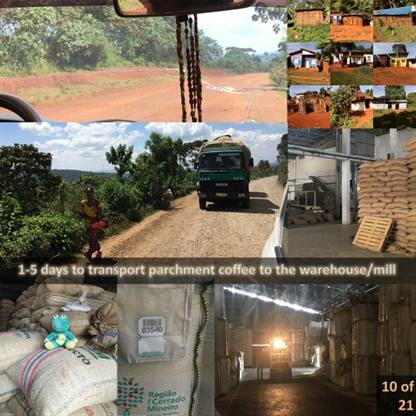
Step 11: Final QC, Auction and Agent Sales
Final QC early contracts, preparation for auction an agent sales. Duration varies – typically less than 60 days, ideally sooner is better.
At this point, the parchment coffee is sitting in a warehouse and is waiting to be purchased before it is milled. The coffee has to be assessed (or re-assessed for those that were assessed where processed). For most countries, it is at this point that quality lots are separated from commodity lots. Quality lots attract higher prices, so that is what drives this process. After defect assessment per lot, lots that qualify are roasted to spec and cupped by at least three certified Q-graders (sometimes more). Also, at this stage, any certifications are put in to place. Many certifications of coffees are related to certain growing constraints, others are reward-based. Here the coffee certifications are allocated.
The final base price per lot is determined by the C-price + points for quality and certifications. Some places like @caravelacoffee do not consider the C-price, they set their own base prices they feel reward the farmers better. For some countries and for coffee that does not make the grade, the price will be established at the coffee auction.
Some roasters and coffee-agents may be present at the assessments and will note the lots or even put in an offer now. Each country has its own rules around if this can be done. Kenya, for example, requires that all the coffee goes on auction. Most countries use a mix of public auctions and private sales or contracts. For roasters with long-term relationships, samples are sent at this point, so they can commit to the lots they want. Those few places where we have got this right; we feel very privileged to have these relationships. We are also saddened by those we have lost.
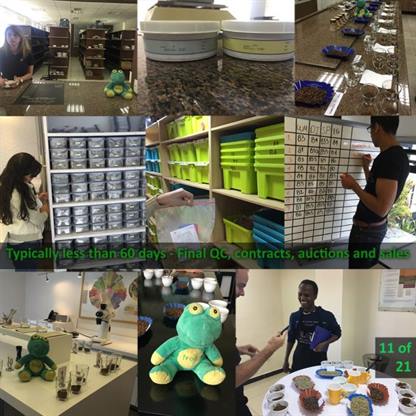
People in photos are Sandra from @Expocaccer in the top left, Salome middle left, Fernando middle right from @caravelacoffeee and @AndreBolton now from @sevenoakscofee and Emmanual from @hallesallase bottom right. The pictures from the QC sample rooms and cuppings that we attended.
Step 12: Auction
An actual auction is typically done and dusted in a day. However, lots that are on auction have been separate as per yesterday. Agents and roasters assess lots and take note of the days the lots are up for auctions.
There are two major types of auctions private and public. Some countries do not allow private auctions. Typically private auctions are of the better scoring lots.
Private auctions usually are by invite only. Some coffee auctions can be held over the internet; many offer limited and special lots. Serious buyers are only invited. A famous and prestigious auction is the Cup of Excellence auction held by the ACE (Alliance for Coffee Excellence). Another is the best of Panama, which often sets world coffee price records. Most of these private auctions take the same format. Those invited are offered a set of lots that have already been separated, having scored a minimum cupping score. Over several rounds, these coffees are scored. Each round only the top coffees make it through, eventually determining a final list of top coffees. At this point, details of the top N coffees will be released for people to bid on at the auction. Coffees that did not make the cut may be sold privately to attendees who like particular lots.
Lot numbers are used in public auctions too. Every country has some form of auction; the largest is Brazils. Modus used is country-specific. A famous one is the Kenyan auction (bottom row in the pic). Kenyan is sold via this public auction. Bidding is by pressing the button (bottom left). Winning bid is displayed at the top of the board. In Ethiopia, coffee is sold via the ECX auction. A link on the pic is so you can watch the auction, which is done through several secret hand gestures.
All coffees not sold on auction are made available at discount prices and sold as a country lot—a reason why single origin can be confusing as a category. Rejected lots are sold by size grading only. For example, a Brazilian Santos or, Colombian Excelso or Honduran Bromelia fancy are just size graded coffees.
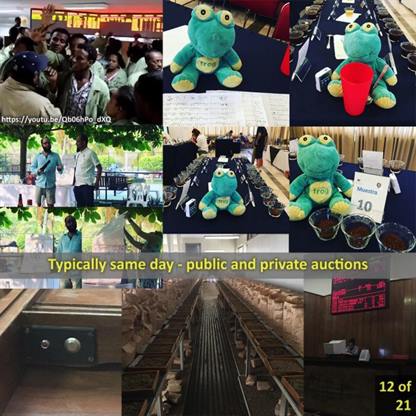
Step 13: Milling
Milling typically takes 1-2 days. Some countries mill before the sale is made, or even mill the coffee wet (like in Indonesia). However, it is more typical that milling is done once the coffee is sold.
Milling has many processes. Some mills are more thorough and have more processes others are not. Here are the usual steps:
- Precleaner– cleans any foreign mater off the beans.
- Destoner– removes any matter that is too heavy.
- Huller– removes the outer layer of dried fruit or parchment.
- Polisher for washed coffees– polishes the coffee.
- Screening– only largest size gets through rest added to grade based quality.
- Gravity grader– using gravity removes any less dense beans.
- Optical sorter– removes black bean and/or insect-damaged coffee
- Manual sorting tables where defects are removed by hand.
- Bagging per weight– coffee bag created and weighed to spec.
- Sewing and sealing of the bag.
- Storage preparation for dispatch.
For sales of a full container of coffee rather than bags, then for them, they actually place a bag in the container that is as big as the whole container. All the coffee is then blown the bag. This allows for about 15% more coffee in the container.
Once again, all rejected coffee is bagged and sold as lower grade lots.
Pictures used are from Brazil and Ethiopia. The ladies in the picture where from Addis Export and they are essentially doing the same as table sorting. Top right is the unprocessed coffee silos. Top middle are the optical sorters, then a picture of a sorting table, and a gravity sorter. A collage of the process is middle right. The bottom is a panoramic shot of the Addis Export Mill.
Besides the fact that mills are expensive to build and kit out, often milling also requires a government-issued license. These obstacles make it hard for a farmer to offer coffee directly unless they have a mini mill. @caravelacoffee own their own mill in Colombia and work with partners in other countries, allowing them to control this process. In Brazil, we work with a co-operative that is owned by participating farmers. Giving more money to the farmer in the end.
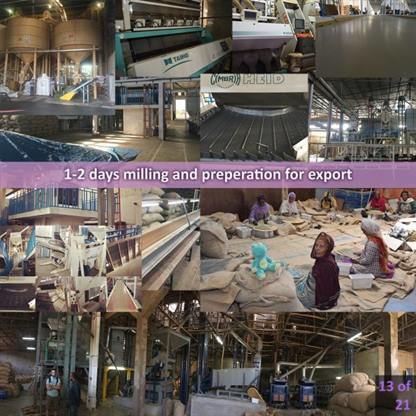
Video of the complete process here:
Step 14: Transport from the Mill
Transport from Mill to destination port time varies from 14 to 200 days, depending on the destination.
Most coffee leaves the mill with the destination being a coffee agents’ or countries’ coffee warehouse. Coffee is trucked across the origin country to the port (sometimes the mills are at or near the port). Then shipped usually via cargo ship (some coffees use airfreight, but these are typically the exception or very high-quality auction lots). Across the seven seas to a destination port.
No matter how it gets there, it has to leave growth origin and arrive in the country where it will be roasted. This has been the case since days of the silk trade and eventually when the Dutch originally started the coffee trade in the mid-1700s.
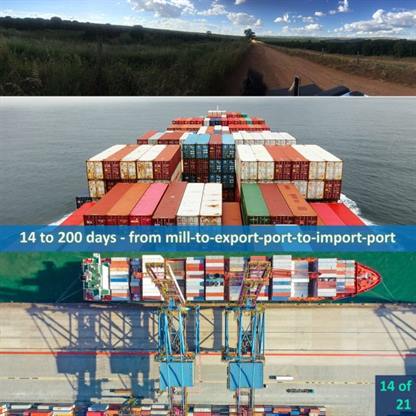
Photos from Unsplash, contributors: @serjosoza, @nessa_rin
Step 15: Arrival at Destination Port
Once the coffee has reached the destination port of the buyer, it has to be cleared through customs. For this to happen, a lot of paperwork is required. In most countries, a Phytosanitary certificate is required. This certificate verifies the coffee is NOT infected with disease, insects or anything that could upset the local fauna and flora. Many countries also have a levy on coffee imports, especially countries that grow coffee. Several producing countries either charge high levies or do not allow coffee in at all.
Those countries with VAT will slap that on now. The buyer needs to settle that long before they are able to sell. For small buyers, this can tie up cash flow.
Coffee is often sprayed with a general–purpose disinfectant and insecticide as the container is opened. It is also inspected, so it can be either punctured or opened.
The time it gets off the cargo plane, or ship and ready for transport to the buyer varies. Typically it is 1-3 days however we have had shipments get stuck waiting for inspection and release. We have several additional documents we always have at hand just in case.
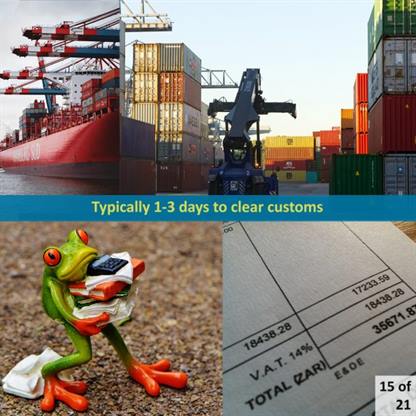
Photos from Pikrepo, and our personal stock
Step 16: Warehousing
The coffee warehouse is the hub of the coffee industry. There are three basic types of Warehousing.
The largest are the warehouses in New Jersey (which is called the New York market), the UK – run by Volliers (and called the London market), Hamburg and Amsterdam.
Hamburg is the largest import and export port of coffee worldwide. These major warehouse stock levels are linked to the trading futures of the commodity price of coffee.
Higher stock levels of coffee in the various first world countries will result in lower future prices (along with the seasonal changes at origin). Called the C-Price by coffee people, it is essentially the base price of Brazilian arabica for a size grade of 15-18 with no real lot separation taken in to account or quality. There is also a c-price for Robusta which now is more linked to the Vietnamese volumes and the London stock market.
The next type is the green coffee agent warehouse. Often these are co-hosted in the larger warehouses. Still, for countries like South Africa, there is no real centralised warehouse. These warehouses have essentially two groups of coffee. The pre-ordered contracted coffee that a roaster ordered direct from the origin and the warehouse, typically these are pre-sold. However, the second group is the largest; it is called spot coffee. Spot coffee is the coffee the agent has to now sell to the roasters. Within the spot coffee, there will be a range of quality. The percentage holding varies per agent. However, worldwide coffees that are considered specialty coffee (i.e. zero major defects +less than 2 minor defects in the green, and cups above 80) is around 15-20% depending on the crop. These coffees start at a premium of at least twice the price of the most certified c-grade coffee. Price increases with the cup score.
The last type of warehouse is a roaster’s warehouse. Here the coffee roaster has either had coffee shipped directly (and has cleared the coffee themselves), or they have pulled stock from the above warehouses. Volume varies per roaster and their model.
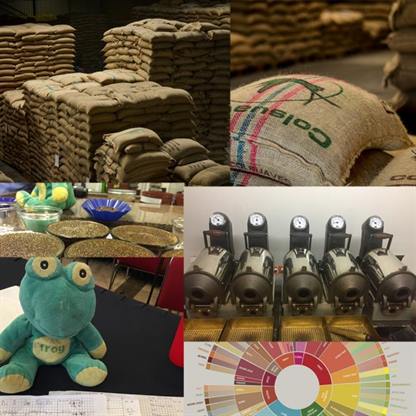
Thanks to @sevenoakscoffee for the pictures of the coffee warehouse.
Step 17: Agents and assessments
Once all the coffee is in the warehouse, each coffee is grouped by their allocated lot numbers. Lot sizes vary depending on many factors. The largest lots are generally lots that are size graded, smaller lots would have been quality separated lots. An agent (a good one that is) that wants to sell their coffees, all these coffee are cupped per lot. Localised tasting notes are created by cupping with local water and local roasting standards (well actually agent–specific standards). While cupping is typically about quality here, it is more about tasting notes with scores playing second fiddle.
Armed with tasting notes, the agent can then assist roasters in identifying which coffees, may suit the roasters specific requirements. Notes are published on offering lists. Also, agents will work directly with roasters to make recommendations.
How long does this take? Well, this is the trick –agents want to only hold coffee for a short period. Ideally, the best time period is the time it takes for a new season of the coffee to be on its way to the warehouse. That is the balance. So less than 365days means the agent has chosen well and found clients for their coffees. More than that and they start losing money.
In 14 years, we have seen many agents come and go. Most of them that had an offering of more than 10% specialty coffee, no longer operate in South Africa. This fact has forced most roasters in South Africa who want to offer real specialty coffee, to look outside of the country to the international warehouses and agents. While this may not be ideal, our hands have been forced. We would love to only have to look for specialty coffees in our back garden.
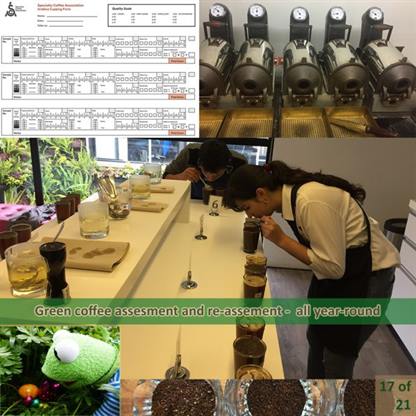
Step 18: Samples and Cupping
Most roasters select coffees by requesting samples first. For roasters working direct, pre-crop samples are sent. Pre-crop samples are normally early released coffees from the processing. A pre-existing relationship is required to be in place for this to work. Quaffee prefers to work this way. However, we have struggled to maintain relationships with many of the producers and local origin–based representatives. Our most successful has been with @CaravelaCoffee.
The most common way a roaster gets samples is from the green agent. A roaster selects from the offering list or contacts an agent with a specific request. These are called spot coffees. Agents could be in the same country as the roaster or other another country. Sometimes agents will hold cuppings for many roasters, so sample roasting is done for them. Roasted samples are also sent to roasters. A methodology we have never felt comfortable with. We prefer to roast and taste the samples ourselves.
Once a roaster receives the samples, they are roasted, rested and then cupped. Ideally, this should be within 2-3 days of receiving the samples. If the roaster takes too long, the coffee could be sold before they get back to the agent.
Our personal methodology is to roast and cup within a day of the roast. So we aim for 2 days. We typically have an idea of what we are looking for. If we are looking for a particular flavour profile for an origin, we will then cup as many coffees as we have for that origin and select. If we are looking for a coffee to replace one we are running low on, then we will cup a few from that region or origin and select the one that we feel represents the flavours of that region. While we seldom cup with price as a variable, we have learnt that real exceptional coffees that cost us more, just do not sell as much as we would like. So price does come into it eventually.
Roasters that select Spot Coffees then have to go through the export and import process, which we have covered already in steps 14-16.
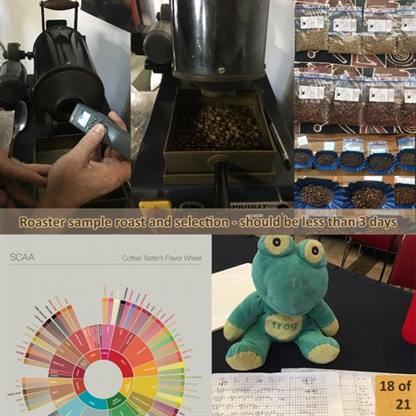
Step 19: Finding a roasting profile
Usually, once a roaster selects a coffee they want to offer, a profile for that coffee has to be developed. A coffee is roasted using various profiles and then cupped. Often this process is repeated until the flavour notes that roaster prefers. You can see in the top right of the picture two different roasting profiles. Larger roasters will have at the very least have a dedicated Q-Grader, or some person responsible for the final flavour notes.
Depending on the roasting equipment, and the preferences of roasters, different options are available to the roaster in developing the profile. However, all are about manipulating convective, conductive and radiant heat, and when it is applied to the roast. While the science of roasting is still new, it is alleged that there are thousands of flavours in coffee. Identifying these flavours is the skill of the roaster and their cupping team.
Commercial roasters may rely on automated profiles. Typically a group of tasters will determine either the automated profile or more how to alter their commercial blends as per the taste profile of the coffee that was roasted.
A principle here is to understand that each roaster and their team will have different goals when roasting. A single coffee can have many ways of presenting in the final brew, and this is why a boom of so-called “artisan” roasting has occurred worldwide. Not only will each roaster select different coffee, but they will also roast it differently.
A general rule of thumb though is that a roaster is restricted by the quality of the coffee they select in the first place. Credence is that a good roaster gets out of the way of a good coffee. A bad roaster reverses any good done in all the previous steps the coffee has taken up until it is roasted.
Worth noting is that green coffee changes as it ages and often this part of the process will need to be repeated to extract flavours from the coffee that the roaster wants to present to their clients.
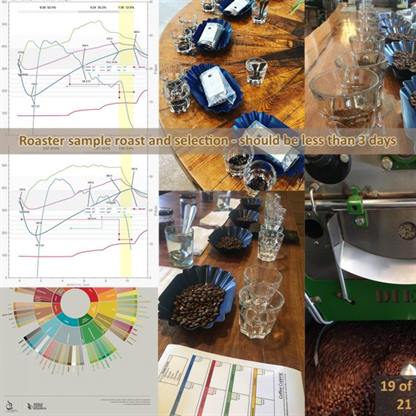
Step 20: Resting, Blending and Packing of coffee 0-36 days
Resting Coffee, unlike Ethiopia where coffee is drunk fresh from roast, most coffee drinkers believe coffee needs to be rested before it is consumed. Old-school commercial roasters will rest coffee for up to 36 days, allowing the coffee to degas quite a bit before packaging. But most roast-to-order roasters let their clients decide when is best to enjoy the coffee. The general rule of thumb is for pressure brewing allowing the coffee to rest helps with an even extraction of the coffee. The enemy of a pressure-based brew (like espresso) is CO2, too much can mess with the extraction, and reduce the “crema”. Feedback from our clients for pressure brewing is anything from 4-17 days the coffee is at its best. For other brews, the coffee flavours change as the coffee ages. Which one suits you is up to you.
Coffee Blending – Though it is common for coffee to be blended in the roaster, many blends are made post-roast. The advantage of this method (besides the fact that all coffees roast differently) is that blends can be changed after the coffees are cupped. Of course, there are those roasters that do not blend coffees. Unless coffees are from single day pickings and single lots, they are blended in green form at origin, so most coffees are by their nature blends, even if they are “single” origin blends.
Coffee Packing – Commercial roasters typically have large automated packing machines. Many of these do it all, labelling, making the bag and sealing it. The foil bag is popular for this reason. Some believe packing is key to their brand. Packaging for us should, firstly, be recyclable, than functional. You can read more about this on our website. There are a lot of claims about packaging that include using Nitrogen or Nobel gas flushing, one-way valves and the like. Once again, information on the success of these is covered in one of our other posts.
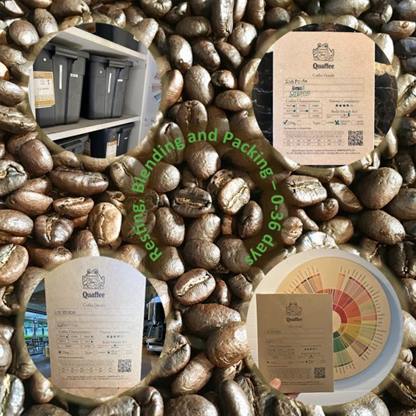
Step 21: Brewing
This is where you come in. How you brew your brew is up to you. There are so many online brew guides now, the last thing we plan to do is to excite more electrons to tell you how to brew.
The basics are dose, yield and time. Dose is how much coffee you use. Yield is how much coffee liquid ends up in your cup. Time is determined by your grind size (and your brewing method) of course. Play with them.
Did you know that each of our coffees has our starting brew recommendations? Check them out. Why do we call it a starting brew? We prefer not to prescribe how you grind, measure, and extract your brew. We all have our own preference on how our brew should taste: more body, more fruit, less fruit, sweeter, nuttier etc. Play. Let each brew be your guide.
